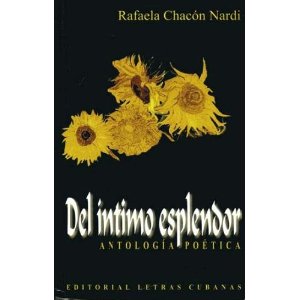4.1.3.2.1 “La Rafaela de Cuba” (1926 – 2001), her poetic work from 1959 onwards

Rafaela Chacón Nardi embraced the life and poetry of the new times and the epic spirit that lay at its core without losing the uniqueness that had characterized her until then. The great collective losses of the first revolutionary decade also find a foothold in her poetry, for example, the verses of “Homage to Conrado and Manuel,” from 1962, in which the elegiac tone prevails over the sadness caused by the murders of literacy teachers Conrado Benítez and Manuel Ascunce.
The elegiac also predominated in the poet’s later notebooks, a result of the perennial shock of her circumstances, where she discovered the definitive conjunction between the intimate and the social, something that other poets of her generation, not always with the same success, tended toward. Along these lines is the 1978 collection of poems, “Of Silence and Voices,” in which political themes are internalized and expressed in verses with the quality and matrix of an intimate subject, as in “Birth of My Island.”
He also wrote the titles “De Rocio y de Humo” (Of Dew and Smoke) (1965); “Coral de Aire” (Air Coral) (1982); “Una Mujer Desde Su Isla Canta” (A Woman Sings from Her Island) (1994); and “Mínimo Paraíso” (Minimal Paradise) (1997). The latter contains his décimas, evidencing his mastery of this type of composition. Neo-Romanticism extends through these verses, as does patriotic sentiment, in a tone close to the colloquial but not openly colloquial, resembling a “whispered conversation,” as some scholars describe it.
One of the author’s most anthologized poems, even included as her best piece in “Two Hundred Years of Cuban Poetry” by Virgilio Lemus, is “To My Bones,” which is part of the aforementioned compilation by Félix Pita, entitled “Coral de Aire.” This poem reveals the intimate dilemmas, personal circumstances, and even the siege of illness and death that the author endured:
“Dislocated, without direction or destination,
broken from here to there, from south to north,
leaving the body useless – without support –
denying me the ability to walk and even the path.
So it came to my bones, so it came
this being and not being a cross or a spring,
This immobility, this bad bearing,
this reliance on plaster and platinum.
Death is solicitous, vigilant,
He followed me until I fell.
She accompanied me – solicitous and loving –
In the bitter days and in the calm
from the Hospital… But I came back to life
with the stubbornness of the sun or the wild palm tree.”
In 2000, her book “Del íntimo esplendor” was also published, contributing to the dissemination of her work among young people, to whom she also directed her reading promotion and community culture efforts in general. These activities, her teaching work, and the outstanding achievements of her poetic works earned her the “Alejo Carpentier” medal in recognition of her boundless dedication and commitment.
Regarding the poetess, Nicolás Guillén had stated with his key word: “a voice of tears and music, which are the great substances of which poets are made.”








